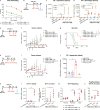Engineered red blood cells as an off-the-shelf allogeneic anti-tumor therapeutic
- PMID: 33976146
- PMCID: PMC8113241
- DOI: 10.1038/s41467-021-22898-3
Engineered red blood cells as an off-the-shelf allogeneic anti-tumor therapeutic
Abstract
Checkpoint inhibitors and T-cell therapies have highlighted the critical role of T cells in anti-cancer immunity. However, limitations associated with these treatments drive the need for alternative approaches. Here, we engineer red blood cells into artificial antigen-presenting cells (aAPCs) presenting a peptide bound to the major histocompatibility complex I, the costimulatory ligand 4-1BBL, and interleukin (IL)-12. This leads to robust, antigen-specific T-cell expansion, memory formation, additional immune activation, tumor control, and antigen spreading in tumor models in vivo. The presence of 4-1BBL and IL-12 induces minimal toxicities due to restriction to the vasculature and spleen. The allogeneic aAPC, RTX-321, comprised of human leukocyte antigen-A*02:01 presenting the human papilloma virus (HPV) peptide HPV16 E711-19, 4-1BBL, and IL-12 on the surface, activates HPV-specific T cells and promotes effector function in vitro. Thus, RTX-321 is a potential 'off-the-shelf' in vivo cellular immunotherapy for treating HPV + cancers, including cervical and head/neck cancers.
Conflict of interest statement
All authors have or had employment and equity ownership in Rubius Therapeutics during conduct of research or currently. M.L. is currently an employee of Takeda Pharmaceutical Company Limited, Cambridge, Massachusetts, USA. M.N. is currently an employee of Merck & Co., Inc., Boston, Massachusetts, USA. A.K. and C.L.C. are currently employees of Catamaran Bio, Inc., Cambridge, Massachusetts, USA. A.L. is currently an employee of Kymera Therapeutics, Inc., Watertown, Massachusetts, USA. D.C.M. is currently an employee of MoMa Therapeutics, Inc., Cambridge, Massachusetts, USA. L.A.T is a scientific founder and holds equity in Rheos Medicines, Inc., Cambridge, Massachusetts, USA, and is a scientific advisory board member and holds equity in Solid BioSciences, Inc., Cambridge, Massachusetts, USA. T.J.W. is currently an employee of GentiBio, Inc., Boston, Massachusetts, USA. The trademarks of Rubius Therapeutics, Inc. – including Red Cell Therapeutics, RCT and RTX, are owned by Rubius Therapeutics and may only be used with its express permission.
Figures






References
Publication types
MeSH terms
Substances
Grants and funding
LinkOut - more resources
Full Text Sources
Other Literature Sources
Medical
Molecular Biology Databases
Research Materials

